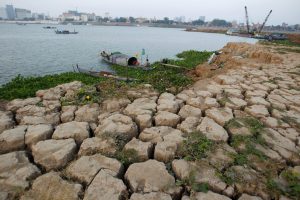A recently published report by Eyes on Earth, Inc. has pointed the finger at Chinese dams holding back water as having significantly contributed to the major drought impacting the Mekong River in Southeast Asia. The drought’s effects have been felt by millions and hamper efforts to support development in the region. Whether it is done maliciously or out of lack of concern, controlling the flow of the Mekong is another way China exerts influence over its immediate region.
The report’s findings, which have been contested by China, added further weight to the growing concern over Beijing’s control of the vital waterway, which begins in China as the Lancang then flows through Laos, Myanmar, Thailand, Cambodia, and Vietnam, supporting over 60 million people. Water levels in the Lower Mekong were recorded at levels unseen in 50 years and have substantially impacted fishing and agricultural activity – which includes 20 percent of the world’s freshwater fish catch. Vietnam, where the Mekong flows into the sea, has been particularly impacted.
The Mekong enables Vietnam to be the world’s second largest coffee producer and third largest rice exporter. Vietnam accounts for an estimated 42 percent of the Mekong’s irrigation equipped land and the river supports tens of millions of Vietnamese, including many subsistence farmers and disadvantaged poor.
The report provides evidence to back up concerns that Chinese dams have held water from the Mekong to fill local reservoirs for long-term storage. China has constructed 11 giant dams along the mountainous territory of the Upper Mekong to sustain its ever-increasing energy needs. The management of water flows has long been a concern for many living along the river. The situation is particularly exacerbated by fact that there are no water treaties or agreements that allow the sharing of data between China and Lower Mekong countries.
Dams further down the river, built and proposed, also pose a significant threat to the health and vitality of the Mekong. The proposed Chinese-backed Sambor Dam in Cambodia would potentially generate more power than is in fact used by Cambodia. However, its intended use would be for exporting a majority of its generation to Vietnam and Thailand. Environmental impact reports revealed the dam would cause major disruption to migratory fish flows and the movement of nutrient-rich sediment into Vietnam. However, these warnings of an environmental disaster in the making appeared to have initially gone unheeded.
A result of lobbying from international NGOs and internal reporting, in March this year the Cambodian government decided on a decade-long dam moratorium on the mainstream of the river. While this places the Sambor Dam on hold, the government has not ruled out potential construction on tributaries. The Cambodian moratorium leaves Laos, which operationalized two major dams in 2019, as the only Lower Mekong country pursuing hydropower on the mainstream of the river.
A landlocked country, Laos has strongly pursued hydropower both to meet local energy needs and also as an export product. Partnering with the Chinese government and entrepreneurs through the Belt and Road Initiative, the opaque Laotian Government has approved over 140 dams along the Mekong and its tributaries. Heavily indebted, Laos stands at a high risk of collapsing under the weight of its debt to China, leaving it dangerously susceptible influence from Beijing.
When visiting Thailand in 2019, United States Secretary of State Mike Pompeo singled out China’s decision to limit the flow of water as the main reason for drought conditions plaguing the region. Alan Basit, president of Eyes on Earth, added weight to Pompeo’s remarks by stating that “the data does not support” China’s position that its dams are not contributing to drought impacts.
China carefully controls and manages the data from its dams. However, the Eyes on Earth Inc. report has placed a spotlight on the Upper Mekong, showing that for half of 2019 China held back vast volumes of vital water from flowing down the river. That significantly added to the impact of the drought on the millions of people who are supported by the Mekong.
Whether through its own dams or the financing and construction of hydropower projects in other countries, China is largely in the driver’s seat when it comes to the Mekong.
It has been previously noted that scientific reports have had little impact on regional policymakers, though in recent times some progress on dam moratoriums has been achieved. However, the increasing evidence of self-interest from China, coupled with the exacerbating effects of climate change and growing georegional tensions, may see impacted states begin to complain more loudly about the Mekong’s mismanagement.
Philip Citowicki was an adviser to former Australian Foreign Minister Julie Bishop and a former Political Aide to Australia’s High Commissioner to the United Kingdom.

































